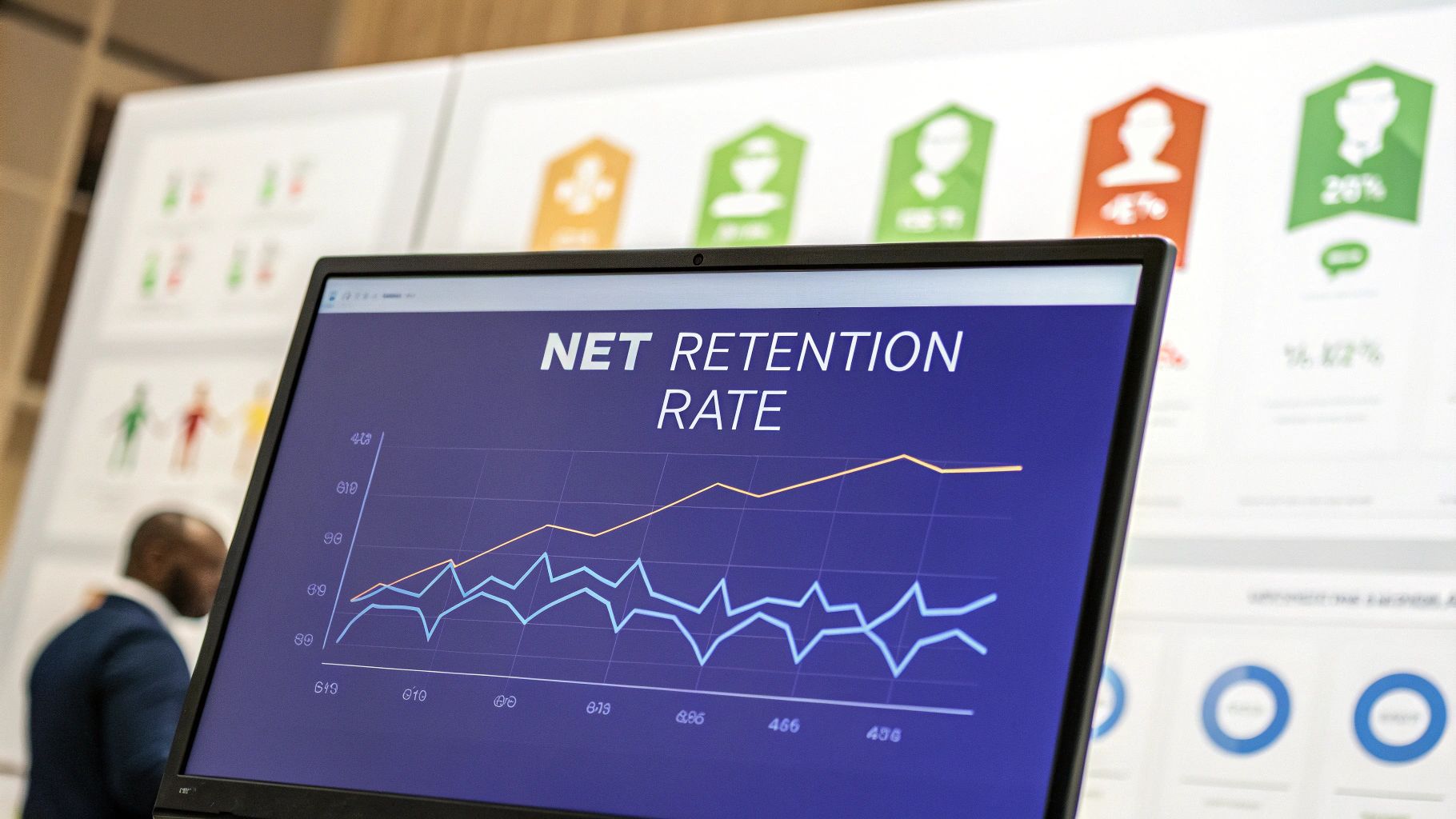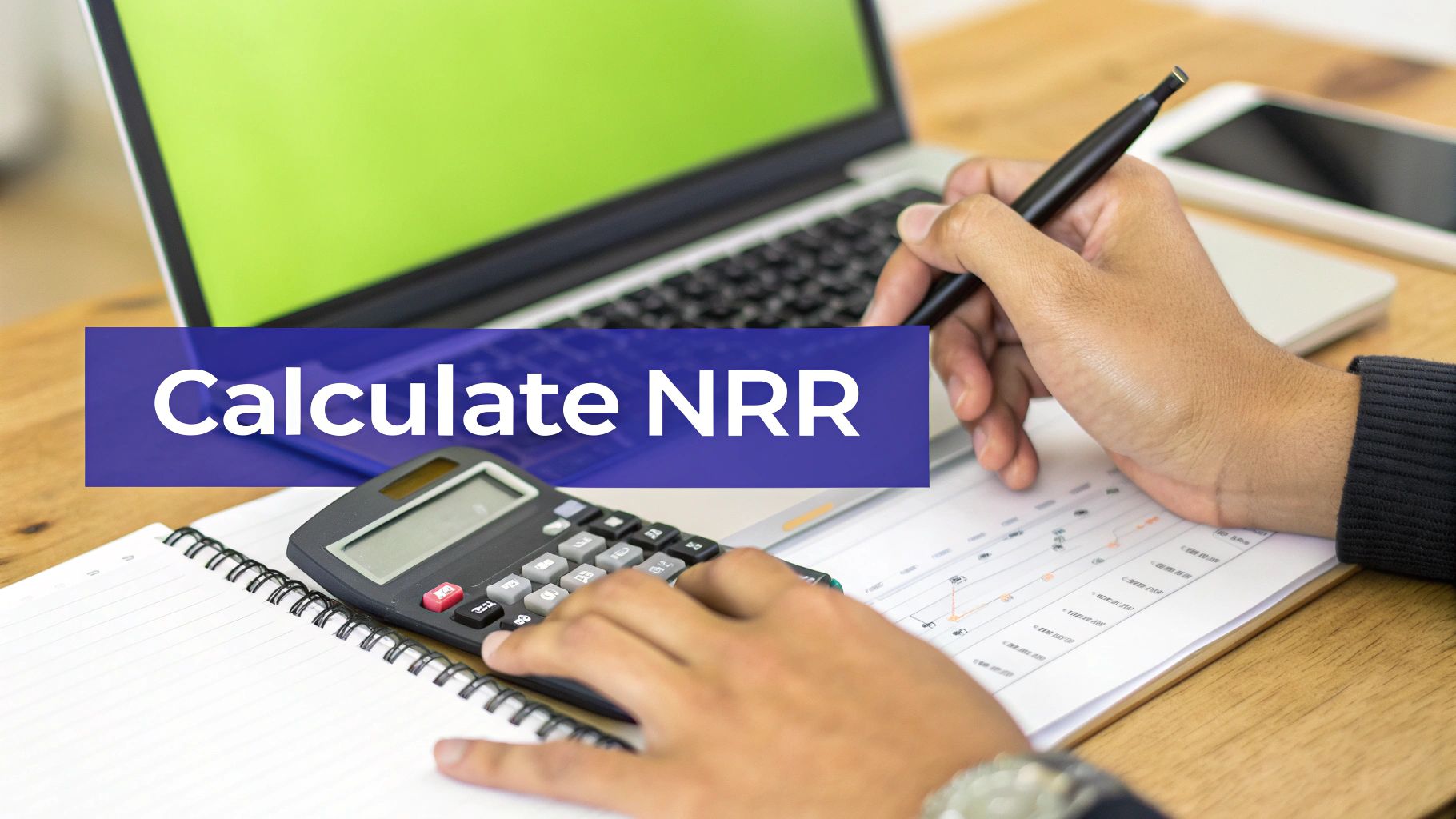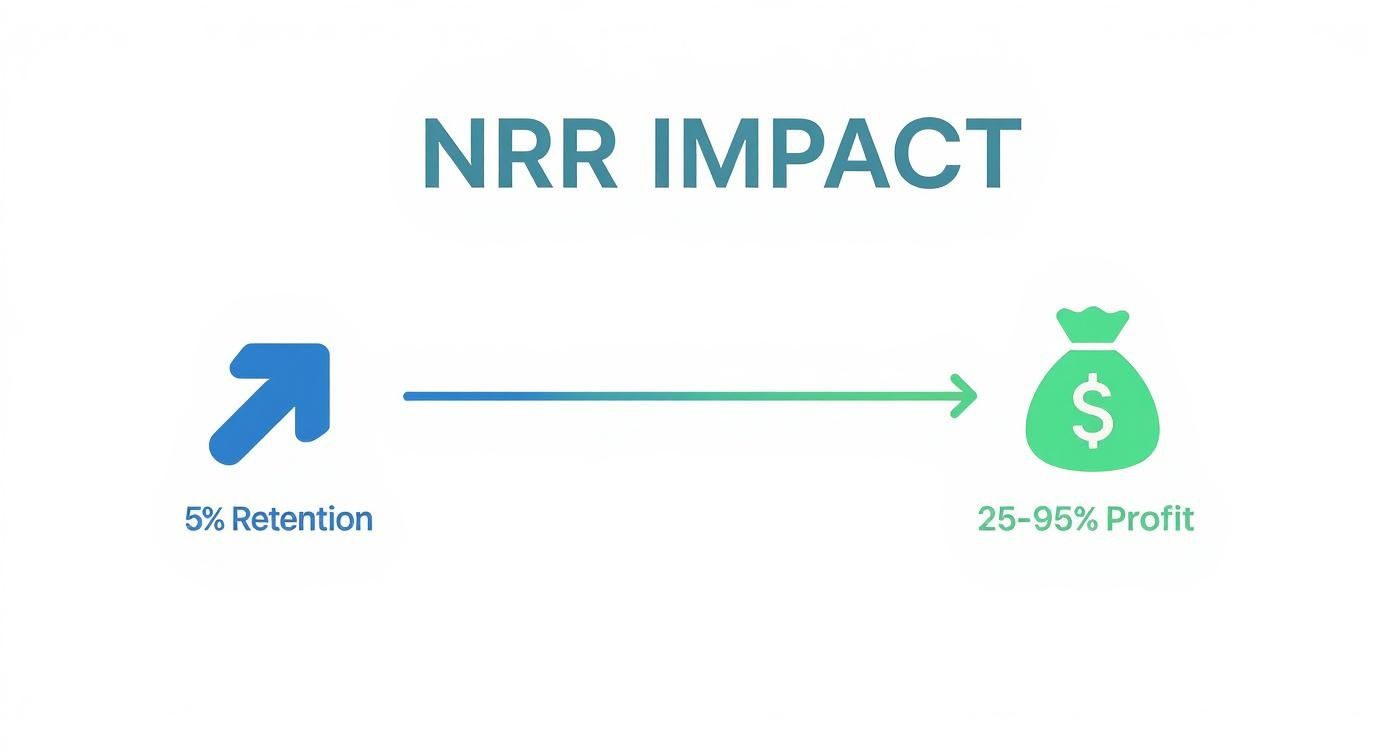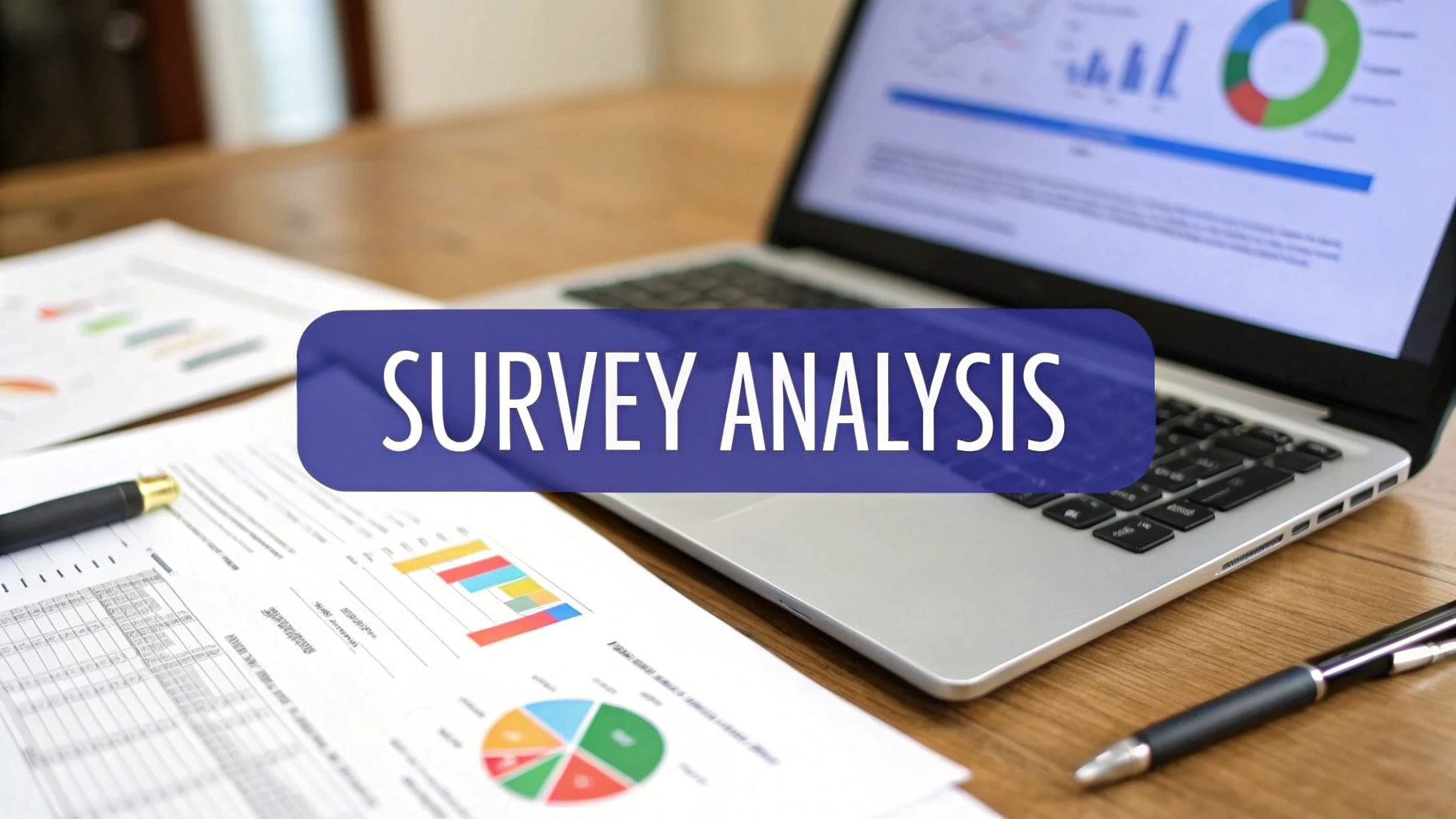Understanding Your Net Retention Rate
Discover how to calculate your net retention rate and why it's a vital metric for SaaS growth. This guide offers actionable strategies for improvement.

Net Retention Rate, often called NRR, is a metric that tells you how much your recurring revenue has grown or shrunk from your existing customers over a certain period. It factors in revenue from upgrades and expansions, and subtracts the revenue you lose from downgrades and cancellations.
If your NRR is over 100%, you're in a great spot. It means your existing customers are generating so much new revenue that it's more than making up for any losses. Your business is growing even without signing a single new customer.
What Is Net Retention Rate
Think of Net Retention Rate as a health check for any subscription business. It answers an important question: are your customers sticking around and finding more value in your product over time, or are they slowly slipping away? This one metric gives you a surprisingly clear picture of customer loyalty and how "sticky" your product is.
Let's use an analogy. Imagine your customer base is a bucket of water. Churn, when customers cancel, is like a leak in that bucket. But expansion revenue, which comes from customers upgrading their plans or buying more services, is like pouring more water in. NRR measures the net result of these two forces.

The Core Components of NRR
To get the full story behind your net retention rate, you need to track three key financial movements within your existing customer base:
- Expansion Revenue: This is all the extra recurring revenue you generate from your current customers. It includes upsells (customers moving to a pricier plan) and cross-sells (customers adding new products or features).
- Contraction Revenue: This is the revenue you lose when customers downgrade their plans or reduce their usage. They're still with you, but they're spending less.
- Churned Revenue: This is the total revenue hit you take when customers cancel their subscriptions and walk away for good.
A high NRR is a powerful signal that the value of your customer relationships is actually increasing over time. It tells you that your business is healthy and that customers are finding so much ongoing value in your product that they're willing to invest more in it. This is exactly why investors and SaaS leaders are so obsessed with this metric.
A strong Net Retention Rate means your business can grow even without adding a single new customer. It proves your product becomes more valuable to users over time.
This metric forces a shift in focus. Instead of just chasing new logos, it highlights the importance of nurturing and growing the relationships you've already built. Since keeping and expanding an existing customer account is more cost-effective than acquiring a new one, a high NRR is a direct line to profitability and long-term stability. It's proof that you've built a sustainable engine for growth.
How to Calculate Your Net Retention Rate
Calculating your Net Retention Rate might sound complex, but it’s actually pretty straightforward. Think of it as a health check for your existing customer base, giving you a clear picture of how your revenue is growing (or shrinking) over a specific time, like a month or a year.
You’ll sometimes hear it called Dollar-Based Net Retention Rate (DBNRR), but it’s the exact same metric. The core idea is simple: are you making more money from your current customers than you're losing when some of them leave?

The Net Retention Rate Formula
To get started, you just need to pull a few key numbers for the period you want to measure. The formula itself is a simple way to combine these figures and see the net change in your recurring revenue.
Here’s the formula in a nutshell:
NRR = [ (Starting MRR + Expansion MRR - Churned MRR) / Starting MRR ] x 100
Let’s break down exactly what each of these pieces means for your business.
Understanding Each Component
To get an accurate calculation, you need to know the three main parts of the formula. Each one tells a different part of your customer revenue story.
- Starting Monthly Recurring Revenue (MRR): This is your baseline. It's the total predictable revenue you had from all existing customers at the very beginning of the period you're measuring (say, on the first day of the month).
- Expansion MRR: This is the additional revenue you gained from that same group of starting customers. It includes revenue from upsells (customers upgrading to a pricier plan) and cross-sells (customers adding new features or products).
- Churned MRR: This represents the revenue you lost from that initial customer group. This number lumps together revenue from customers who canceled their subscriptions entirely (cancellations) and those who moved to a cheaper plan (downgrades).
Putting these metrics together is what makes NRR so powerful, as it shows the true health of your customer relationships. For a deeper look at how retention connects with long-term value, you can learn more about how to calculate LTV for SaaS companies.
A Practical Calculation Example
Let's walk through a real-world example to see how this all comes together. We’ll use a fictional SaaS company to make the numbers easy to follow.
Here’s a quick breakdown of their month:
| Net Retention Rate Calculation Example |
| :--- | :--- | :--- |
| Metric | Description | Example Value |
| Starting MRR | The total recurring revenue on the first day of the month. | $100,000 |
| Expansion MRR | Additional revenue from upgrades and cross-sells. | $15,000 |
| Churned MRR | Revenue lost from cancellations and downgrades. | $5,000 |
Now, let's plug these numbers into our formula:
[ ($100,000 + $15,000 - $5,000) / $100,000 ] x 100
[ $110,000 / $100,000 ] x 100 = 110%
In this scenario, the company's Net Retention Rate is 110%. That’s a fantastic result. It means that even after losing some revenue to churn, they still grew their revenue from existing customers by 10% that month. They didn't just replace lost revenue; they outgrew it.
Why NRR Is a Foundational SaaS Metric
So, why does Net Retention Rate get all the attention in the SaaS world? To put it simply, it’s one of the most powerful vital signs for your business's long-term health. A high NRR means your customers are sticking around and finding so much value in your product that they're willing to pay more for it over time.
When your NRR ticks over 100%, that's when the magic really happens. It means the new revenue from your existing customers (think upgrades and add-ons) is completely covering any revenue you've lost from cancellations. This creates a powerful, self-sustaining growth engine that doesn't rely entirely on the constant and expensive hunt for new customers.
The True Cost of Customer Acquisition
It's almost always cheaper to keep the customers you have than to find new ones. Happy, loyal customers tend to spend more as their own businesses grow, which feeds directly into your profitability. This relationship is exponential.
In fact, some research shows that a tiny 5% bump in customer retention can boost profits anywhere from 25% to 95%. This is especially true in industries with high customer acquisition costs, where the compounding value of a happy, long-term subscriber is just massive.
A Signal of Financial Health
Beyond what it means for your internal growth, a strong NRR sends a clear, positive signal to investors and the market. It tells them you have a stable, predictable revenue stream and a business built on a solid foundation.
A healthy Net Retention Rate proves you've achieved strong product-market fit. It shows that your product solves a real problem so effectively that customers become more dependent on it over time, not less.
Of course, NRR is just one of several metrics for a subscription business. Knowing how it works with other key performance indicators gives you a much fuller picture of how your company is really doing. For a broader look, you can check out our guide on essential customer retention metrics.
Ultimately, focusing on your Net Retention Rate is about playing the long game. It’s a direct reflection of your ability to build lasting relationships and deliver continuous value, the cornerstones of any successful SaaS company. When your customers stay and spend more, you create a flywheel effect that fuels scalable, profitable growth for years to come.
Understanding Net Retention Rate Benchmarks
So, what’s a “good” net retention rate, anyway? The truth is, there's no magic number. It really depends on what industry you're in. Knowing the benchmarks for your field gives you a realistic yardstick to measure your own performance and set goals you can actually hit.
Think of it as knowing the average score for a video game level. It helps you see if you're on track or if you need to step up your game.
Generally speaking, an NRR above 100% is a great sign. It means your expansion revenue from existing customers is more than making up for any revenue you're losing from churn. You are growing with your customers, not just keeping them.
For high-growth SaaS companies, the target is often even higher, think 120% or more. Hitting that kind of number shows your product is incredibly sticky and your customers are deeply loyal. On the flip side, an NRR below 100% is a red flag. It tells you that your revenue from existing customers is shrinking, which is a clear signal to tackle churn or figure out new ways to expand those accounts.
How NRR Differs Across Industries
It's no surprise that different business models lead to different retention rates. Let's look at a few examples.
The business-to-business (B2B) world, especially in SaaS, tends to see strong NRR. This is because B2B relationships are often built on larger contracts, deeper integrations into a client's daily workflow, and long-term partnerships. When your software becomes a key part of how a company operates, they're much less likely to leave.
On the other hand, e-commerce businesses often face a tougher battle. Their customer relationships can be much more transactional. With so much competition just a click away, building the kind of loyalty that drives repeat purchases and high retention is a constant challenge.
This chart really drives home just how much a small bump in retention can boost your profits.

The takeaway here is pretty clear: even tiny improvements in keeping your customers can have a massive impact on your bottom line.
Average Net Retention Rate by Industry
To give you a clearer picture, here's a look at how average net retention rates can vary across different sectors.
These numbers aren't set in stone, but they provide a solid starting point. They highlight how different business models and customer relationships naturally lead to different retention outcomes. Use them as a guide, not a strict rule.
Setting Realistic NRR Goals
Knowing these industry differences is the key to setting targets that make sense for your business. If you're running a B2B SaaS company, shooting for an NRR over 100% is a perfectly reasonable goal. But if you're in e-commerce, a smaller, steady increase of just a few percentage points could be a huge win.
The real goal is continuous improvement. A "good" NRR is one that's consistently trending upward, proving you're delivering more and more value to your customers over time.
Comparing your NRR to industry benchmarks gives you the context you need to evaluate your performance. If you're looking for ideas on how to keep those customers sticking around, be sure to check out these proven SaaS customer retention strategies. Ultimately, these benchmarks are just tools to help you build a stronger, more resilient business.
Actionable Strategies to Improve Your NRR
Alright, so you know your net retention rate. That's the first step. The real work is making that number climb.
Boosting your NRR boils down to two things: keeping the customers you have and finding ways to grow their accounts. A few practical strategies can make a massive difference.
First impressions are everything. A smooth, intuitive onboarding process helps customers see the value in your product right away. When users have a clear "aha!" moment and see how you solve their problems from day one, they're far more likely to stick around for the long haul.

Drive Expansion Revenue
The fastest way to push your NRR over that magic 100% mark is by increasing expansion revenue. This is all about encouraging your current customers to spend more, either by upgrading their plans or adding new features.
To do this right, you have to genuinely know what your customers need. Look for opportunities where an upsell or cross-sell solves a real problem for them. This might look like:
- Tiered Pricing: Offer higher-tier plans with advanced features that growing businesses will naturally need as they scale.
- Add-On Features: Provide optional features that customers can bolt on to extend the functionality of your core product.
- Usage-Based Models: Let customers pay more as their usage increases, creating a natural path for account growth.
Think about a communication platform that offers a premium tier with advanced analytics. As a customer’s team grows and their need for deeper insights becomes apparent, upgrading becomes an easy, logical decision. This approach perfectly aligns your revenue growth with your customers' success.
Proactively Reduce Customer Churn
Reducing churn is the other side of the NRR coin. Every customer you keep is revenue you don't have to scramble to replace. Proactive churn management means spotting at-risk customers before they even think about leaving.
Your data is your best friend here. Look for warning signs like a drop in product usage, a lack of engagement with key features, or a sudden spike in support tickets. These are all signals that a customer might be unhappy. Once you've identified these accounts, you can reach out with targeted support to get them back on track.
Preventing a customer from leaving is almost always cheaper and easier than acquiring a new one. A proactive retention strategy directly protects your recurring revenue and gives your NRR a major boost.
For example, simply having great customer support and engaging proactively can make a huge impact. You can explore more effective strategies to reduce customer churn to build out a solid retention plan. To get a better handle on this metric, take a look at our complete guide on the SaaS churn rate.
Use Feedback to Guide Improvements
Finally, you can't improve what you don't know. Gathering customer feedback is absolutely necessary for making smart product and service decisions. Tools that collect feedback at scale, like AI-powered surveys, can give you a crystal-clear picture of what customers love and where you're falling short.
With a platform like Surva.ai, you can automatically gather feedback at key moments in the customer journey. This information helps you pinpoint friction points, see why customers churn, and uncover new opportunities for expansion. By turning customer sentiment into actionable insights, you can continuously improve your product and keep your NRR moving in the right direction.
Common Mistakes to Avoid When Tracking NRR
Getting a handle on your net retention rate is one of the smartest ways to check the pulse of your business. But a few common slip-ups can give you a completely skewed picture, and making decisions based on bad data is a recipe for disaster.
One of the most frequent mistakes? Tossing revenue from brand-new customers into the mix.
NRR is all about the health of your existing customer base. When you add new customer revenue, you artificially inflate the rate. This can easily hide some serious underlying problems, like customers quietly churning or failing to upgrade.
Incorrectly Accounting for Revenue Changes
Another classic error is fumbling how you handle different types of revenue. It's absolutely vital to exclude any one-off income, like initial setup fees or special consulting projects. These are not part of the ongoing subscription value, and including them will throw your NRR way off.
On the flip side, you have to be just as careful with downgrades. Lumping them in with your total churn numbers or, even worse, forgetting them entirely can mask real issues with customer satisfaction or product-market fit. An accurate NRR depends on clean data that clearly separates expansion, contraction, and churn.
Relying solely on NRR without considering other metrics can paint a dangerously incomplete picture. For a true health check, you need to look at both net and gross retention.
This is especially true in certain industries. Take e-commerce, for example, where businesses often have a tough time with retention. The average NRR in that sector is a shockingly low 38%. This really drives home how important accurate tracking is, especially when you remember it costs five times more to land a new customer than to keep an old one. You can find more great insights on customer retention benchmarks over at Sprinklr.com.
Finally, never look at NRR in a vacuum. A high NRR might look fantastic on the surface, but it could be hiding a dangerously high churn rate if just a few big accounts are expanding enough to cover the losses. To get the real story on customer loyalty and how "sticky" your product is, always analyze it with your Gross Retention Rate, which strips out all that expansion revenue.
A Few More Things About NRR
Alright, we've covered a lot of ground. But there are always a few lingering questions that pop up when you start digging into Net Retention Rate. Let's clear up some of the most common ones so you can use this metric like a pro.
What’s the Difference Between Gross and Net Retention?
This is a big one, and it's easy to get them mixed up. Think of it like this: Gross Retention is purely about defense. It measures how good you are at holding onto the revenue you already have, completely ignoring any upgrades or expansions. It’s a stark look at your churn.
Net Retention, on the other hand, plays both offense and defense. It includes that expansion revenue, giving you a much fuller picture of how the value of your existing customer base is growing (or shrinking).
Can You Have a Negative NRR?
If your NRR dips below 100%, it's a signal that your existing customers are shrinking in value. That's not great. But a negative NRR? That's a whole other level of trouble.
Mathematically, it's pretty much impossible to get a negative number with the standard formula. What people usually mean when they say "negative NRR" is a rate that's cratered far below 100%. This is a serious red flag, telling you that churn and downgrades are wiping out your revenue much faster than you can make up for it with expansions.
How Often Should I Calculate NRR?
Most SaaS businesses track their Net Retention Rate on a monthly and quarterly basis. There's a good reason for that.
Monthly calculations are great for spotting immediate trends. Did a recent feature release cause a spike in upgrades? Did a price change lead to downgrades? Monthly tracking helps you react fast. Quarterly and annual calculations smooth out the bumps and give you a more stable, big-picture view of your company’s health.
The most important thing? Be consistent. Pick a cadence that works for you and stick with it. That’s how you’ll get reliable data to track progress and make smart decisions.
Is NRR the Same as Customer Lifetime Value (CLV)?
Nope, but they're definitely related. NRR and Customer Lifetime Value (CLV) are two different lenses for looking at customer value.
NRR zooms in on a specific period to measure revenue retention from a group of customers. CLV zooms out to forecast the total revenue you can expect from a single customer over their entire time with you. A healthy NRR is a great indicator of a high CLV, but they are not the same metric.
Ready to turn customer feedback into higher retention? Surva.ai gives you the AI-powered tools to understand why customers stay or leave and automates the actions that keep them loyal. Start improving your NRR today.


